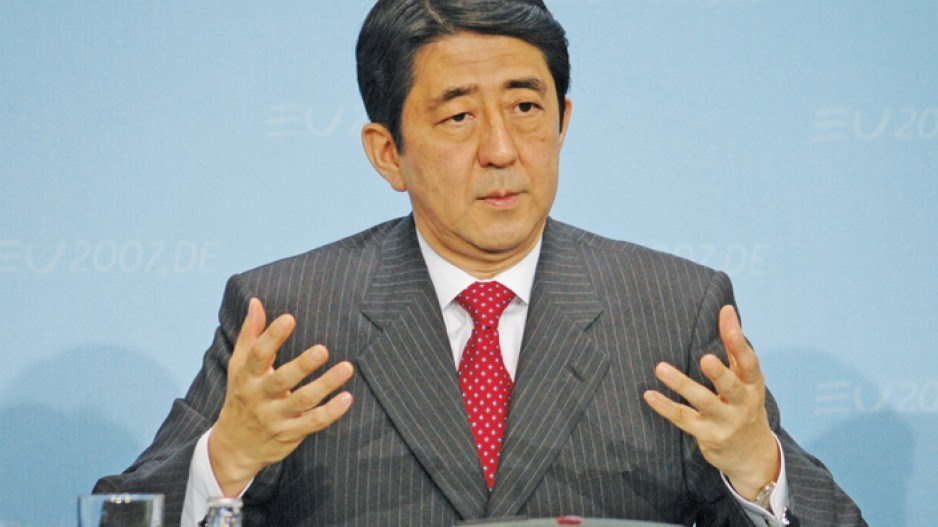The economic miracle promised by Prime Minister Shinzo Abe to revive Japan's long-stalled economy is looking more like a fumbled sleight-of-hand trick by a cack-handed magician.
Abe returned to power in December 2012 at the head of a majority Liberal Democratic Party government, wielding a reform program of “three arrows” he said would re-energize an economy that had been wheezing along for the best part of two decades.
Abe and his ministers argued that at the core of Japan's problems was a lack of confidence in the country's future among its 127 million people. To put a spring in people's step and urge them to open their wallets, Abe has fired his three arrows.
Arrow No. 1 was to print money in order to encourage consumer spending by injecting a degree of inflation into the economy. No. 2 was to give an immediate jolt to the economy with fiscal stimulus. And arrow No. 3 was to promote long-term growth by taking a jackhammer to Japan's economic and business structure of calcified protectionism enjoyed by politically influential special interests.
Well, the first two arrows flew wide of the mark, and Abe has taken aim twice at structural reform, most recently in the middle of this month. But his reform performance and objectives are unimpressive. What he's proposing is more likely to embed Japan's problems than to solve them.
Printing money dropped the value of the currency, the yen, with the aim of making Japan's exports more attractive and engendering a degree of inflation. Consumer prices have indeed risen about 1.5%, but this has come largely from the increase in the price of imports, especially industrial raw materials and oil.
So, instead of rushing out to buy in anticipation of rising prices, Japanese consumers are spending less. They still feel unsure about the future and are therefore cautious about opening their wallets.
One reason for this is that Abe's second arrow, the economic stimulus package, was highly deceptive. The government spending program was the all-too-familiar Japanese practice of throwing money at infrastructure projects of dubious value, but aimed at politically influential sectors. Meanwhile, whatever boost this might have produced was more than offset by raising the consumption tax to 8% in April from 5%, and with a rise to 10% planned for later next year.
Without these two arrows flying straight and true, “Abenomics” was doomed from the start. His fluffing of the shot with the third arrow – structural reform – has compounded the missed opportunity.
At the heart of Japan's gloomy outlook is a lack of competitiveness both in the international and domestic markets. For a country whose essential asset is the skills of its people, this is a sentence to a slow death.
Abe's reform program does little or nothing to address the real problems of protectionism, corporate rigidity and a faltering capacity for innovation, for which Japan was once famous. And the one major effort at reform by Abe and, indeed, previous government leaders, to open up the labour market dominated by cradle-to-grave employment and promotion based on seniority rather than merit, has backfired horribly.
Labour market deregulation, which began in the early 2000s to allow for greater use of temporary workers, has created gross distortions. The “working poor” earning less than the equivalent of $29,000 a year – a third of the average for tenured employees – now make up more than 40% of Japan's workforce.
These people face poor work conditions and equally precarious job prospects. Most importantly for Japan's future, they are losing or not acquiring the skills the country needs to reignite its moribund innovative economy.
There is a growing movement to jettison Japan from the Trans-Pacific Partnership (TPP) free trade negotiations because of Prime Minister Shinzo Abe's reluctance to dismantle the formidable protective barriers around the country's agriculture industry.
While on a visit to Washington earlier this month to see United States President Barack Obama, New Zealand's prime minister, John Key, said Japan should be cut out of the TPP talks if it will not agree to open up its markets to more agricultural imports.
Key's comments come after a statement by six major U.S. farm lobbies late in May, also saying Japan should be suspended from the TPP talks, which involve 12 Pacific Rim nations, including Canada.
Any move to oust Japan from the TPP talks has potential implications for Canada. Canada's subsidy of about $7 billion a year for dairy, poultry and egg producers – known officially as “supply management” – is a sore point with the New Zealanders and Americans.
If completed, the TPP free trade area will cover two-fifths of the world's economy and about a third of global trade. But the proposals are highly contentious in several countries, including the U.S., and therefore making little progress.
Obama needs the power from Congress to fast-track approval of a TPP settlement but has no hope of that before the November mid-term elections, and perhaps not even after that. None of the other countries involved will sign up for a deal until they see what happens in the U.S.
Until now, U.S. negotiators appeared willing to let Japan keep some protection for products such as rice, beef and dairy, whose producers and marketers are politically powerful. The Japanese domestic market for agricultural products is dominated by corporate or co-operative monopolies politically linked to Abe's Liberal Democratic Party, and the country's rural constituencies are grossly over-represented in parliament.




